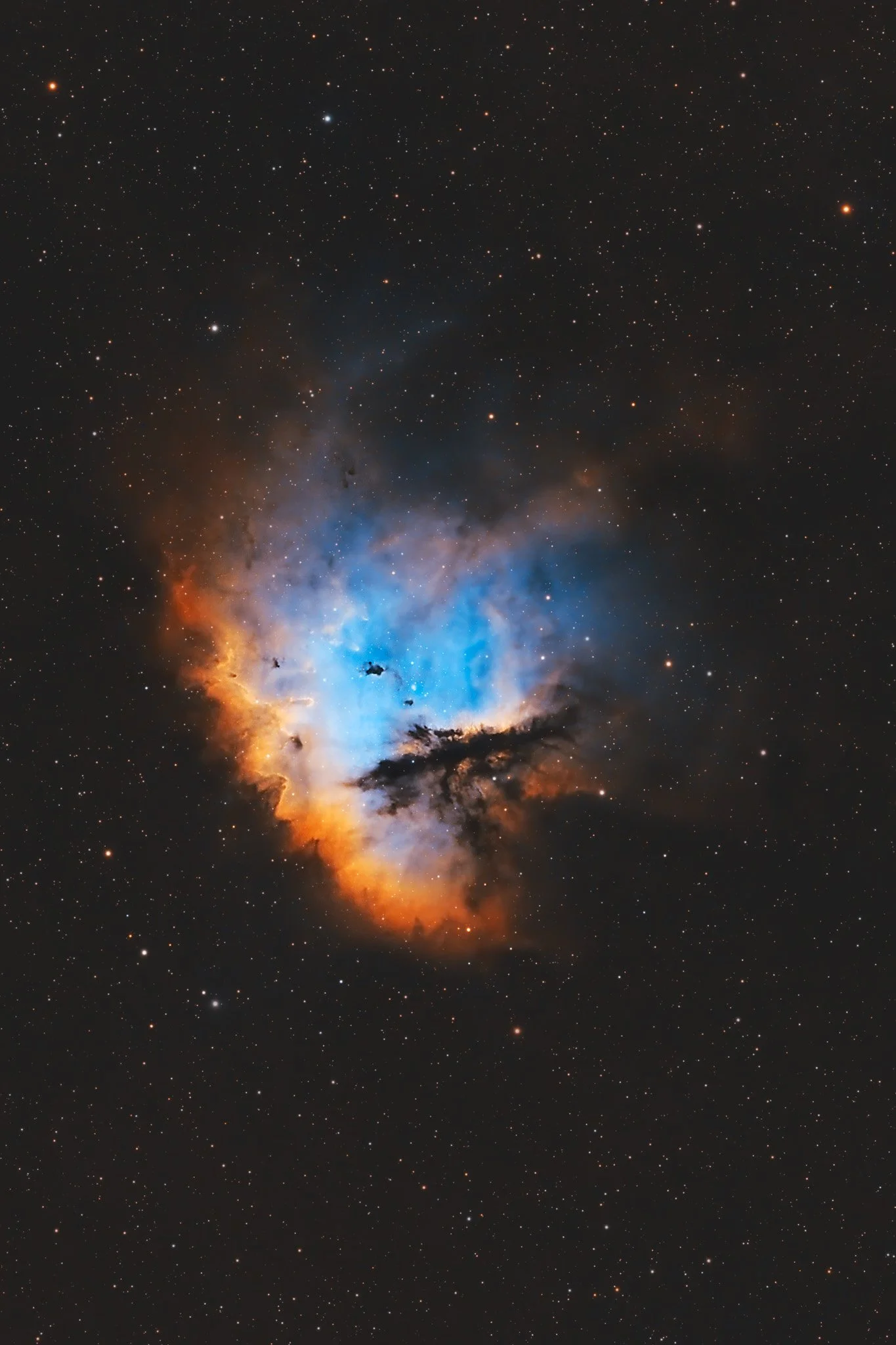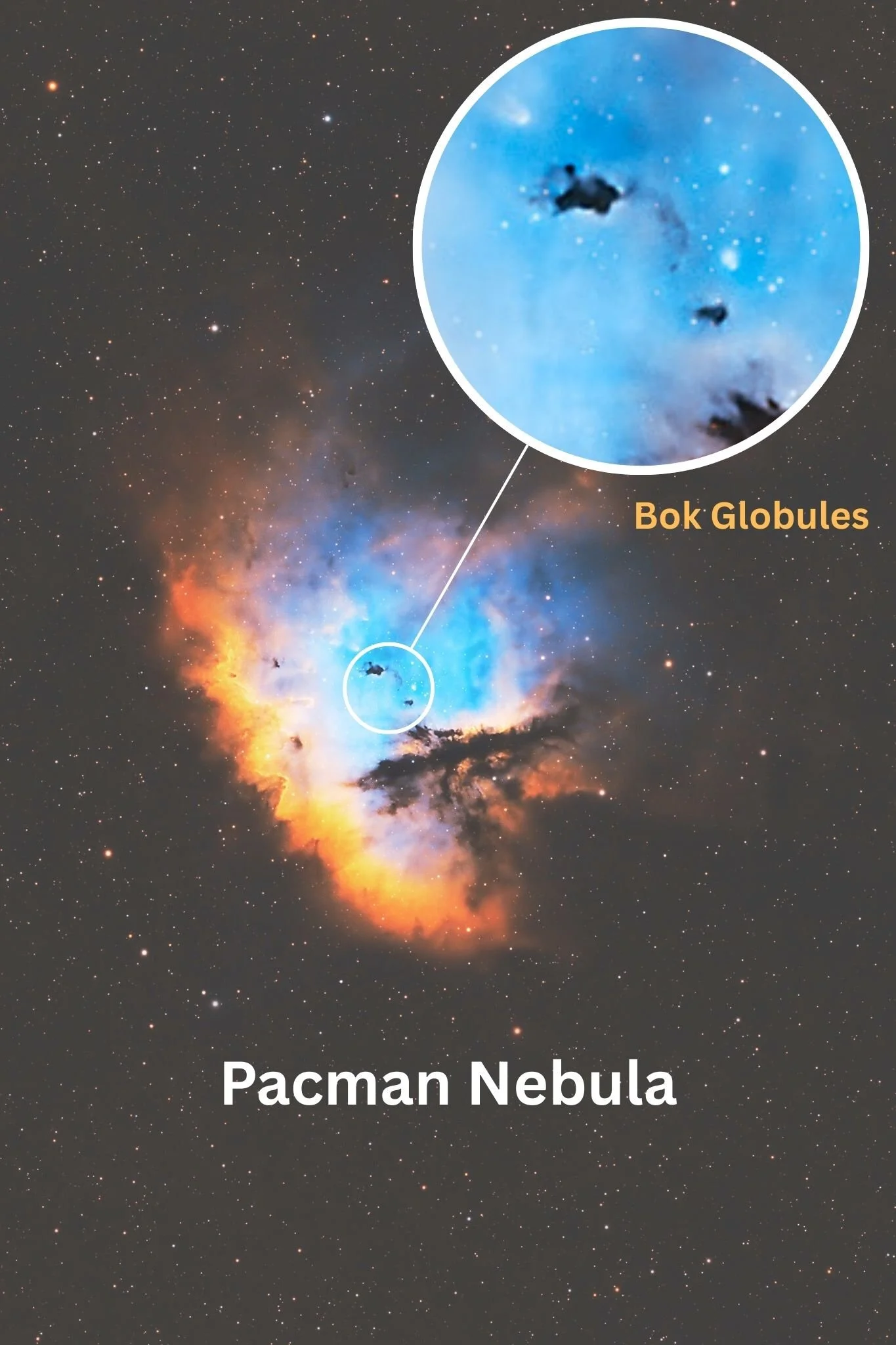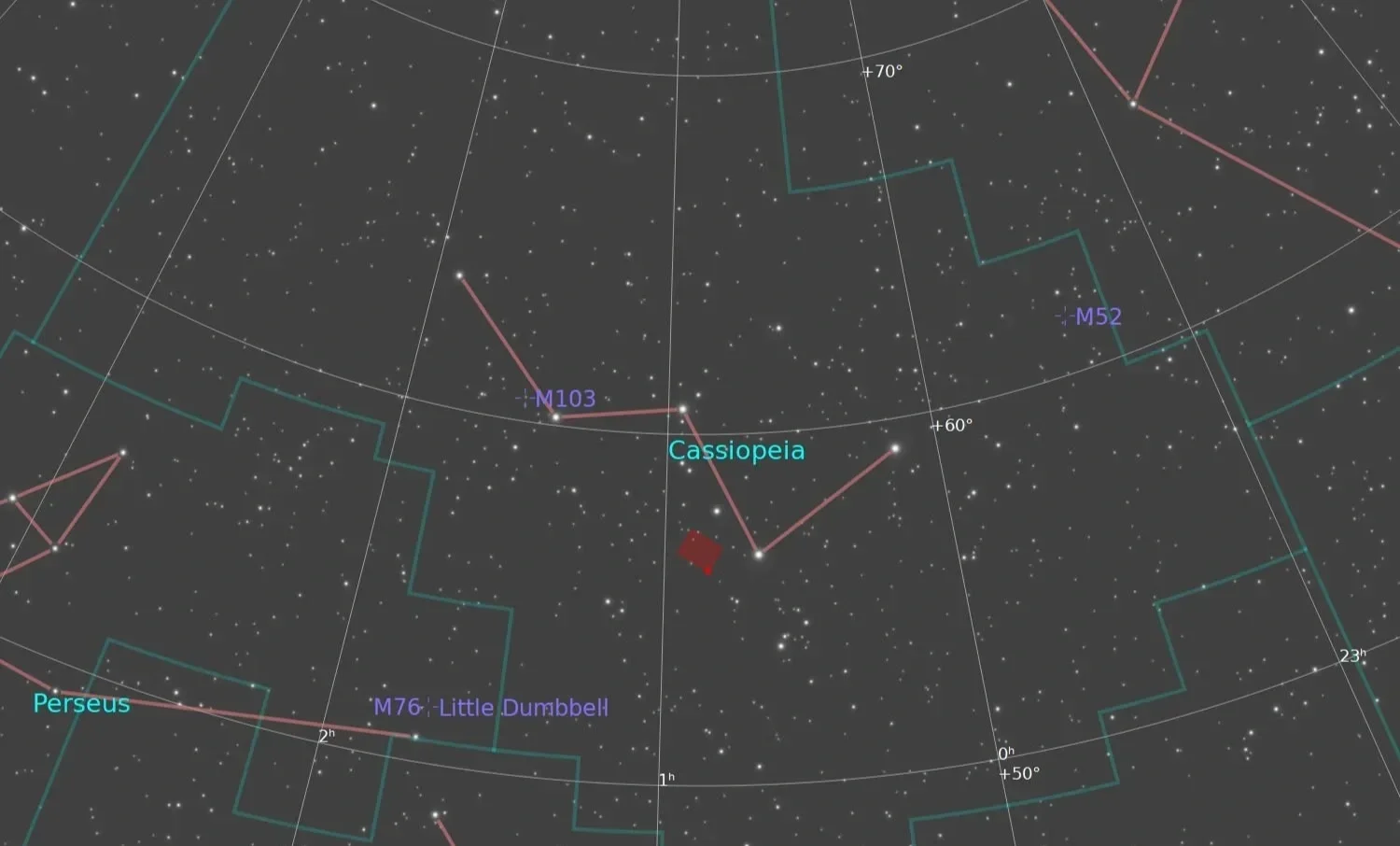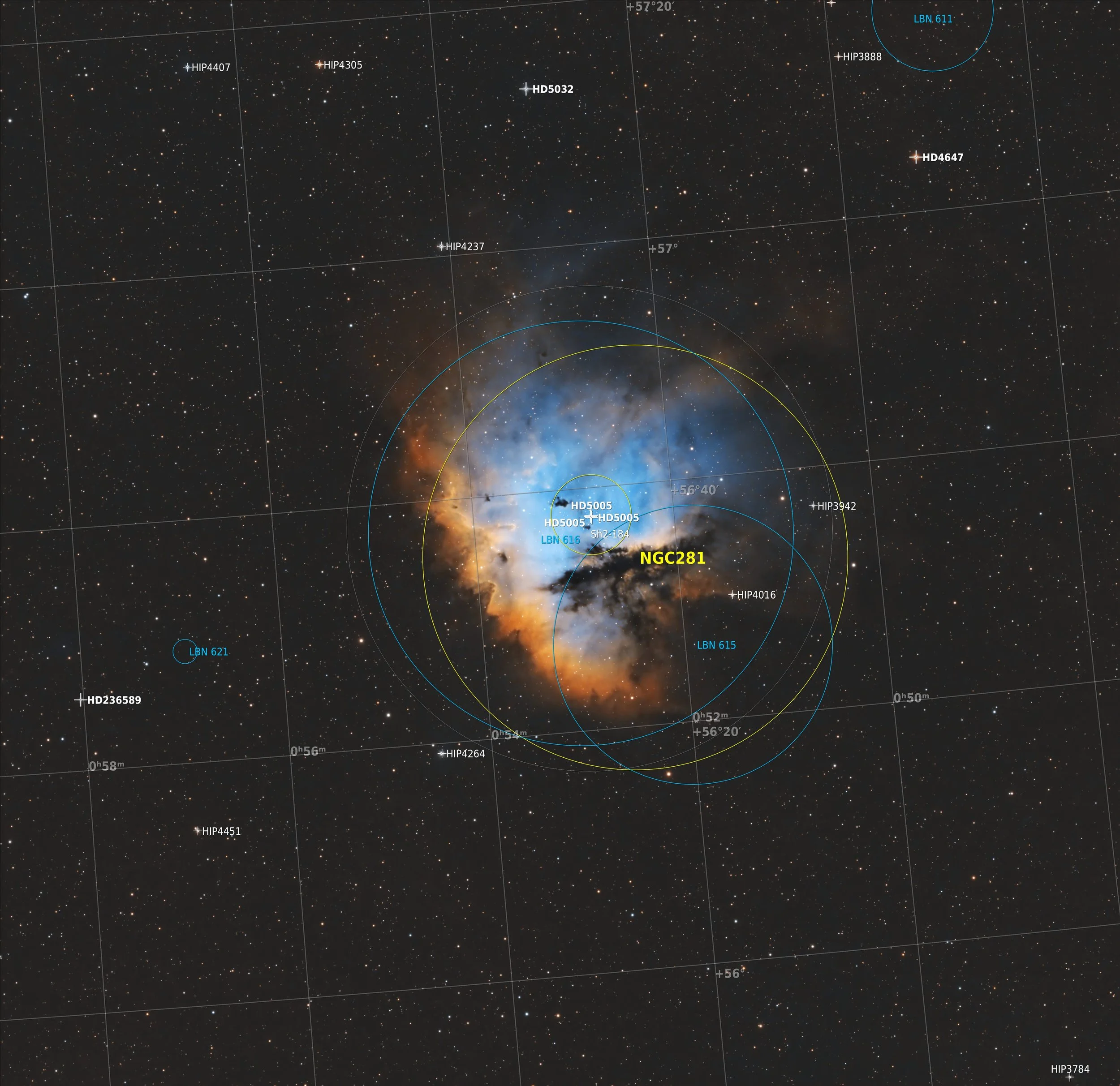The Night Sky - Episode 22
THE PACMAN NEBULA
This is episode 22 in my series on our night sky
If you grew up dodging ghosts on a glowing arcade screen, you’ll recognize this shape instantly: a wide-mouthed arc of darkness biting into a glowing disk. Only here, the “character” spans dozens of light-years, its “mouth” carved by cold dust against a sea of hydrogen light. Meet the Pacman Nebula—an energetic star-forming region tucked into the rich star fields of Cassiopeia.
The Pacman Nebula
A total of 55 exposures of 5 minutes each, for a total of about 4.5 hours of data, were shot to complete this image.
Image by Achint Thomas
What is the Pacman Nebula?
The Pacman Nebula (also cataloged as NGC 281 and Sh2-184) is an H II region—an immense cloud of ionized hydrogen lit by hot, young stars—roughly 9,000–9,500 light-years away in the Perseus arm of our Milky Way. At its heart sits the open star cluster IC 1590, including several massive, blue-white O-type stars whose powerful UV radiation sculpts the nebula and makes it glow.
The “Pac-Man” silhouette comes from intricate dust lanes and a population of Bok globules—compact, cold nuggets of gas and dust collapsing into newborn stars. Through narrowband filters, the nebula paints itself primarily in Hα (deep red) with accents of OIII (teal) around shock fronts and brighter ridges.
Bok globules in Pacman Nebula
Image by Achint Thomas
Two interesting facts about the nebula:
Astronomers have mapped a set of distinct Bok globules in NGC 281 (traditionally labeled B1–B4). Several harbor embedded protostars, making Pacman a superb laboratory for watching star birth in “slow motion.”
The entire NGC 281 complex is believed to sit well above the Milky Way’s mid-plane, likely lifted by the blast waves of past massive-star activity that blew a super-bubble in the local interstellar medium—an elegant example of how one generation of stars seeds the next.
Locating Pacman
Start with the unmistakable “W” of Cassiopeia, high in the northern sky on autumn and winter nights. From γ Cassiopeiae (Navi) trace a short hop toward the Milky Way’s brighter lanes; wide-field charts place Pacman in a busy patch of nebulosity east of the Bubble Nebula/M52 region. With binoculars under dark skies you’ll notice a subtle brightening; in small telescopes, a UHC or narrowband filter helps. For imaging, even a modest telephoto at ~400 mm frames the whole target; the nebula spans about 35–40 arcminutes (a touch larger than the full Moon).
Star chart showing how to locate the Pacman nebula. It is close to the constellation of Cassiopeia.
Capturing Pacman
I approached Pacman as a classic dual-narrowband project. The goal: reveal the crisp H α architecture without crushing the softer O III wisps that accent the “cheek” and inner rim. A narrowband 3nm dual-band filter dramatically tamed light pollution and moon glow, letting the dust lanes pop in silhouette while preserving faint background emission. Guiding kept the 400 mm field of view locked all night, and the camera cooler held the sensor at –10 °C for clean data.
Light transmission curve of the Optolong L-Ultimate filter, a typical dual-narrowband filter. It is designed to allow the transmission of Hα (656.3 nm), Hβ (486.1 nm) and OIII (500.7 nm and 495.9 nm) wavelengths while suppressing all other wavelengths. The tight bandpass of 3nm ensures maximal rejection of light pollution.
For this project, I captured 55 sub-exposures, each 300 seconds long, for a total of about 4.5 hours of integration time. Calibration frames ensured that the final stack would be as clean as possible. In PixInsight, I combined the dual-band data into a natural HOO palette, and then balanced the Hα/OIII signals so the dark “mouth” stayed defined without turning the whole nebula crimson. I also used star reduction and gentle local contrast enhancement to lift the Bok globules and ridge lines. Finally, I masked the dust lanes to prevent noise amplification while preserving the soft, smoky edges that make Pacman feel three-dimensional. The artistic choice here was restraint — letting the negative space of the dust do as much storytelling as the emission itself.
The Region around Pacman
Annotated image of the region around the Bubble Nebula.
Image by Achint Thomas
Cassiopeia is crowded with treasures. Just west lies the M52 star cluster and the Bubble Nebula (which I have captured as well), a perfect one-night-each duo for a weekend under dark skies. Wider fields reveal threads of diffuse hydrogen clouds and the footprint of the Cassiopeia OB associations, whose stellar winds and supernovae have shaped this whole neighborhood for millions of years.
The Pacman nebula is playful at first glance—nostalgic even—but it’s also a snapshot of stellar alchemy: gravity gathering dust into globules, radiation carving caverns of light, shock waves etching edges that look like a bite mark. It’s the universe making new suns, one pixel at a time. If you get a clear autumn night, point your optics at Cassiopeia and take a bite out of this target—you’ll come away with both a classic composition and a deeper respect for the chaos that builds beauty.
Check out some other nebulae I have captured.
Capture details
Camera: ZWO ASI 533MC Pro
Gain: 100
Sensor Temperature: -10°C
Lens: Sigma 100-400mm f/5-6.3 DG OS HSM
Focal length: 400mm (equivalent to 640mm full-frame)
f-Ratio: 6.3
Sub-exposure length: 300 seconds
Number of exposures: 55 (Optolong L-Ultimate filter)
Total integration time: ~4.5 hours
Calibration frames: 30 darks, 30 flats, 30 dark flats
Mount: SkyWatcher Star Adventurer GTi
Guide camera: ZWO 120mm mini
Guide scope: ZWO Mini Guide scope
Capture control: ZWO ASIAir Pro
Dew control: SvBony dew heater
Field Power: AIMTOM 194Wh Portable Power Station
Sky quality: Bortle 3
Moon phase: New moon
Processing: PixInsight






